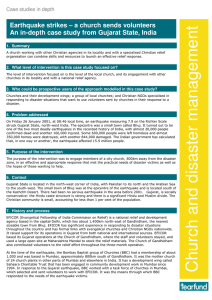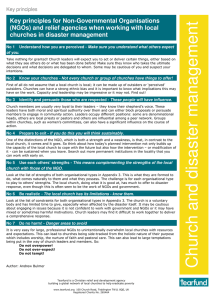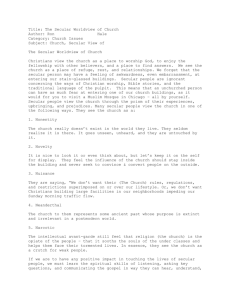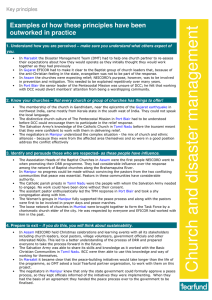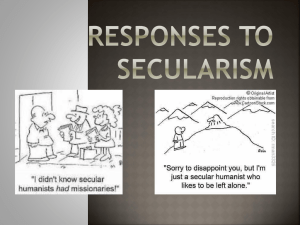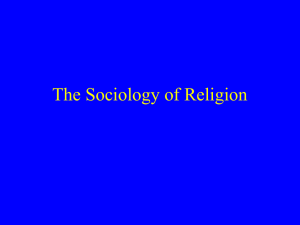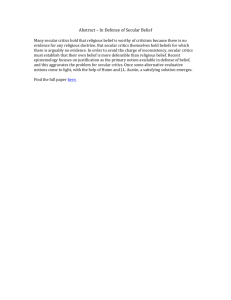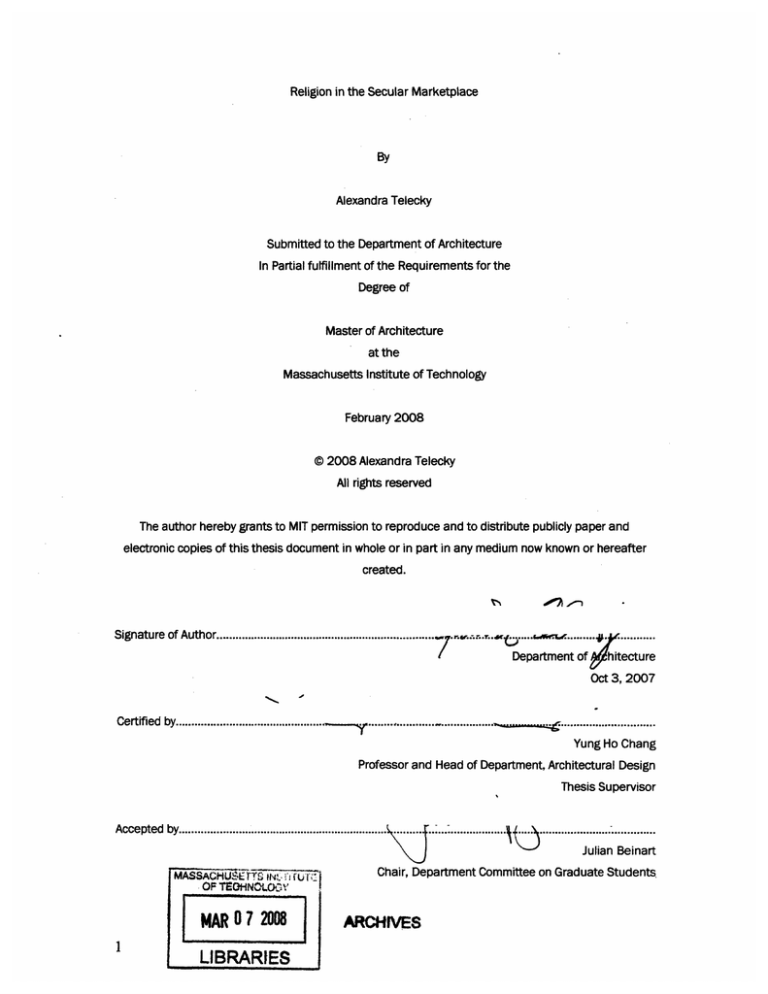
Religion in the Secular Marketplace
By
Alexandra Telecky
Submitted to the Department of Architecture
In Partial fulfillment of the Requirements for the
Degree of
Master of Architecture
at the
Massachusetts Institute of Technology
February 2008
© 2008 Alexandra Telecky
All rights reserved
The author hereby grants to MIT permission to reproduce and to distribute publicly paper and
electronic copies of this thesis document in whole or in part in any medium now known or hereafter
created.
Signature of Author ........................................
......................
..................
/
Department of hitecture
..
Oct 3, 2007
Certified by.................................
.............................
.......................
Yung Ho Chang
Professor and Head of Department, Architectural Design
Thesis Supervisor
Accepted by..........................................................
.....
....
........................
v ..............................
Julian Beinart
•I•
MASSACHUS~EOTS
TU7
Chair, Department Committee on Graduate Students
OF TEOHNOLCLOU
MAR 07 2008
LIBRARIES
ARCHIVES
Thesis supervisor................................................................................................................................................
Yung Ho Chang
Professor and Head of Department, Architectural Design
Thesis reader......................................................................................................................................................
Mark Jarzombek
Associate Dean of the School of Architecture and Planning and Professor
of the History and Theory of Architecture
Thesis reader ......................................................................................................................................................
Nasser Rabbat
Aga Khan Professor of the History of Islamic Architecture and Director
of the Aga Khan Program for Islamic Architecture
Religion in the secular marketplace
By
Alexandra Telecky
Submitted to the Department of Architecture
On October 2nd, 2007 in partial fulfillment of the
Requirements for the Degree of Master of Architecture
ABSTRACT
A design thesis which proposes to create a new religious mall in the growing Texas
suburb of Frisco: a design proposal for interfaith space conceived of as a
'marketplace of ideas' in which religions, religious businesses, and also secular
businesses may come and go according to the demands of the market, and compete
freely with one another for customers.
Sacred space and secular space
"The most exotic religion in the United States is also the most familiar, as strikingly similar to
the society in which it flourishes as it is distant from the religion we once knew."'
This thesis project depends first upon an idea of religion which does not differentiate
between secular and sacred space. Its precedents are not those highly specialized,
permanent, authoritative and rarefied buildings created specifically to evoke the
numinous and to banish thoughts of the secular world from the mind of the believer
with carved stone and controlled light and carefully orchestrated sequences of ritual
spaces. Rather, they are the unexceptional buildings built or appropriated by religions
as they sprout, multiply, divide, combine, or vanish according to the tastes of a
pluralistic society and its members, cultures, and subcultures: warehouses, rented
rooms, houses, theaters, storefronts, gas stations, tents, retail space and commercial
space of all kinds. This kind of ad hoc religious space means different things to
different religious sects, depending upon their theology, their social situation, and the
context. A particular sect may well meet in a warehouse rather than a hand-carved
stone temple unhappily and only because they must. Or they may think of what they
are doing as appropriating space: taking back secular space in the name of their god
or even taking space from a dominant culture and claiming it for their smaller one-a
racial group or a cultural group which is tied to a particular religion and for whose
members the only space in this city or this suburb which truly belongs to them is this
modified storefront or this old theatre building. Many religious sects also attach value
to the idea of poverty, of being impoverished according to the standards of the larger
society within which they exist if not necessarily according to their own.
Preachers once railed against the theaters which competed for the attention (the
business?) of their congregations. Then in the late 1800's churches first took over
old theater buildings and adapted them for use as sanctuary space. It was both a
sort of symbolic gesture-going to what was then considered a 'den of iniquity' and
retaking it in the name of the Lord; holding religious services on what had once been
The Transformation of American Religion p. 3
considered the Devil's home ground; and a pragmatic decision, since these theater
buildings, already designed to hold a large crowd and focus its attention on a single
stage, proved extremely congenial to the purposes of already intensely experiential
and theatrical evangelical preachers looking to bring their revivals indoors or into
more permanent homes. Finally, completely new churches were built which still
imitated the form of those first appropriated theaters.2 In much the same way today,
evangelical megachurches either establish themselves in old big-box retail stores and
megaplex movie theatres or build new complexes which deliberately mimic the forms
of the 'secular' suburban world: the corporate park, the movie theater, and, yes, the
suburban shopping mall. And yet despite this apparent willingness to accommodate
themselves to their surrounding environment, these megachurches' strategy is at the
root of isolation from this secular world, not of engagement with it. As documented in
Loveland and Wheeler's book 'From Meetinghouse to Megachurch', megachurches
create spaces for themselves in imitation of secular spaces. And yet as these authors
point out, this mimicry is not effectively nor is it intended as a way of engaging these
churches and their members in dialogue with the world around them. The
megachurch which provides a whole small city of daycare services, shops, activities,
etc. in a physical environment ostensibly like any other in the area-simply allows its
members to have a community life much like that which they would have outside the
church community, yet exclusively populated by other church members and likeminded individuals. Here are offered the material benefits and atmosphere of secular
society without any of its corresponding 'drawbacks'-the friction between conflicting
points of view, the anxiety and fear which the believer may feel faced with a world of
presuppositions unlike or contrary to her own, the temptations and doubts offered
and fostered in the secular marketplace.3
2From
Meetinghouse to Megachurch, p.
3"In an ocean of secularism, the full service white megachurch served, in the words of the senior pastor of
Second Baptist, Houston, as an 'island' to which the entire family could 'retreat' for education, fellowship,
and recreation. Few white megachurches aspired to the kind of comprehensive cradle-to-grave community
Walt Kallestad envisioned, but most offered programs and facilities sufficient to meet virtually all the
educational, social, and recreational needs and desires of their members, filling most of their after-work
hours and weekends." From Meetinghouse to Megachurch, pp. 188-189
The atrium inWillow Creek Community Church
(p.135, Loveland and Wheeler, "From Meetinghouse to Megachurch: A Material and Cultural History")
In the face of and as a response to these exclusive new enclaves of pseudopublic space, this thesis project proposes a multifaith marketplace in which all
religions may freely compete. Moreover, it proposes a marketplace in which other
more and less secular businesses may compete alongside religion, religious
business, and businesses catering to religion, for the attention and the custom of
passers-by. This project conceives of itself as, first, a possible and in important ways,
humanistic solution to the anomie, to the socially unengaged and inwardly-focused
non-public character of the suburban 'Bible Belt' landscape within which such
churches as these most typically are found. One of the few places where people living
in this region continue to meet with people outside their own families is at their
churches: it is in fact this which constitutes the great attraction of religion for so
many rootless suburbanites moving from anonymous subdivision to anonymous
subdivision in one region to another for their jobs. But proselytizing religions are also
more than this happy association of the like-minded wherever they may go. They not
only offer self-segregating communities to the interested and willing, but go out and
aggravatingly force themselves into the personalized 'bubbles' of exclusive private
space which -uninterested- individuals and families have created for themselves,
potentially expose them to ideas in which they do not believe, and to members of
their society whom ordinarily they consciously avoid.
This project both provides to these existing religious groups their platform to
harangue or woo passers-by, and, by creating a space not exclusively religious in
which arguments and invasions of 'personal space' may occur, potentially offers this
template for social interaction to other social organizations that need not be
specifically religious. Or religious in any sense. As religion has already chosen to
compete in secular spaces with secular forms of community and entertainment on
the terms of secular society, there is nothing at all inappropriate about allowing
religions to meet not only each other but their secular competitors as well on this
ground. That is, there is no reason why in the halls and on the platforms of this
project, the only world-views on offer must be religious.
As nothing but an empty framework offering places to meet, places to publicly
celebrate and to encounter others on the 'street', and places to advertise, this
project takes the organization and the demands of contemporary religions inAmerica
(seen, necessarily, largely with respect to and incompetition with the dominant
paradigm of Christian religion inAmerica) only as a potential starting place and a
template for economic and social interactions of many sorts. For while religions are
offered a place (all that they, fundamentally, need) within this project, they are not
privileged or offered 'pride of place'. Within this marketplace any religion; any
business of any kind willing to fit itself into this framework may rise or fall according
to the market-and the architecture particularly aims to grant it no special immunity,
privilege, or authority beyond that of the market. It is conceived of as so entirely
adaptable that religions, businesses, political or social organizations may succeed
one another here freely, with much greater ease than they may inthe 'big boxes',
purpose-built for one particular business or another and omnipresent around the
proposed site of this project, and for which adaptation to secondary uses after the
original business expires is often a difficult problem.
T
Frisco, Texas: an abandoned big-box grocery along Preston Rd., which runs right through the center of town.
Proselytism, advertising, and the 'religious economy'
"Some readers may shudder at the use of market terminology in discussions of religion, but
we see nothing inappropriate in acknowledging that where religious affiliation isa matter of
choice, religious organizations must compete for members and that the 'invisible hand' of
the marketplace is as unforgiving of ineffective religious firms as it is of their commercial
counterparts." 4
Contemporary religious organizations-American religious organizations in particularalready promote themselves to the general public in the same way as any business,
through aggressive advertising, the careful tailoring of a certain image, and
effectively catering to the desires of their customers.
D.A. McGavran's book 'The Bridges of God' opens by asking the question: 'How do
*peoples* become Christian?'. And the major shift in thinking which this book
proposes to the missionaries of its day is right there: the idea that the church, if its
goal is to convert as many people to the faith as possible, must appeal to 'peoples'
and not 'persons': the object of missionary activity becomes a series of focus groups,
as it were, rather than individuals. And it is this book, written in the 1950's, which
instigated the 'church growth' movement in Christianity. 'Church growth' is what
might be called an 'ends-oriented' approach to missionary activity: the goal is above
all for a church to increase its attendance rate. And the Biblical verse typically quoted
in favor of this approach is 1 Corinthians 9:22: '1have become all things to all men
so that by all possible means I might save some.' And questions of community within
the church and of the way in which the church may in turn contribute to or how it
should behave towards the non-church community are all subordinated to this
overwhelming goal of evangelism. This approach to 'church-building', as it were,
stands in sharp contrast to at least two other relatively recent contemporary
developments in religious community-building in the Christian church: the 'house
church' builders, and the C.E.B./communidades ecclesiales de base. The 'house
church' communities advocate books with titles like 'Church After Christendom'-that
4 The
Churching of America p. 8
is, they typically anticipate a future in which Christianity or religion in general are
*not* ascendant or even especially well-tolerated, and model themselves in theory
upon the early Christian church before it received the sanction of the rulers of Rome:
their primary concern is for the interior quality of the insular communities they build
for themselves, not for the numbers of people they may induct into these
communities, the efficiency with which these communities may or may not convert
non-Christians to the faith, or for what socio-political effect these communities may
have on the secular world. The 'communidades ecclesiales de base', on the other
hand, the product of a very different social situation in a far-removed part of the
world though popular as an idea among the socially conscious religious, are primarily
concerned with improving the lives and social standing of their overwhelmingly poor
membership in the secular and in the political world: the C.E.B.'s are and have been
largely the work of radical 'liberation theologians' whose first concern is always for
the church as ethical actor on the world stage, or what was referred in the early part
of the last century as the 'social gospel': the church working in favor of the poor and
disenfranchised.
The primary uniting activity as well as the main raison-d'etre of the contemporary
evangelical Christian church is proselytism, or in the church's own terminology,
evangelism. Community-building for its own sake and the 'morale' or individual faith
of the many members of these growth-oriented evangelical Protestant churches are
secondary concerns to the main task *of* these churches-to maintain a constantly
increasing membership. As one of the pastors who runs a network of small start-up
churches in the Frisco area told me, such a church is like a living organism, which
either continues to grow or begins to die. This particular church organization,
'Stepping Stones', has chosen to 'seed' many independent mid-sized churches in the
Plano-Frisco-McKinney Texas area rather than to create one leviathan megachurch.
However, this strategy too was explained in terms of the efficiency with which it could
propagate the faith: the idea being, as this pastor also told me, that many pieces of
ice in a glass cool the water faster than just one large chunk. At one Wednesday
evening bible reading (held, like the services of this particular church, in the
conference room of a local motel) which I attended, even the newest members of a
very small new 'seed' church were immediately educated not only in what they
themselves should believe, but also in the proper ways to in turn bring yet more
members into the church by immediately passing on all that they had learned to
others as quickly and as often as possible. But while on the one hand, evangelism
constitutes the individual activity of each member, bringing family, friends, and
acquaintances to the church fold one by one on private initiative (and churches seem
to consider this to be the most effective proven way of expanding their territory),
'evangelism' is also conducted by the church organization itself on a grand scale.
Such churches make liberal use of billboard, of television, of movie theater
advertising-of all the same strategies employed by any area business, in whatever
measure that they can afford.
Any product advertised in these venues offers more than just an efficient new
tile cleaner or a well-made suit: in the hands of the advertiser it becomes the promise
of novel or exciting experiences, or the first step towards a completely new and
improved, idealized lifestyle. The company selling clothes or shoes or cars may do so
by selling them as a part of a complete image of a person whom the prospective
buyer would want to be-the product on the billboard is worn by or driven by or held in
the hands of some model individual, sits on the table of a model home, stands at the
center of a model family. Alternatively, certain ads and strategies of product
placement promise not only the ideal 'real' life, but a small taste of a purely fantasy
life as well: product placement in movies alongside advertisements which steal
images from popular escapist entertainment. And contemporary advertisements for
church services overtly make use of all of these tactics of contemporary advertising.
After the commercial success of the film 'The Passion of the Christ' in the United
States, any number of churches used images from the film or mention of the film in
their advertising campaigns on billboards, television, and in movie theatres, under
text like 'You've seen the film, now get to know the man!'. Likewise, religious
organizations advertise using images of the sort of person that they propose to make
their converts into, living the sort of lives which they will expect their adherents to
lead: a billboard advertising the Frisco Bible Church, located very near the proposed
site of this project, has an image of a child on his grandfather's shoulders; churches
on the more conservative and less accommodating end of the evangelical spectrum
tend to advertise using images of families. More 'modern', what are called 'seekeroriented' megachurches tend on the other hand to use pictures which might just as
easily have been lifted off of the many adjacent ads for new expensive subdivisionstrim men in athletic wear riding bicycles, young laughing individuals and sometimes
families, all of whom seem meant to look reassuringly secular, unexceptional if
successful, and possessed of all the goods which the contemporary secular life
affords to some. 5
"The confident hope that God's judgment and blessing were on their way soon has
both comforted and catalyzed oppressed peoples for centuries. But today many middleclass Pentecostal congregations appear very much at ease with the status quo. Now they
seem confident not that Jesus is coming soon, but that He probably isn't, and that
therefore nothing will interrupt their pursuit of success and self-indulgence." 6
Prof. Harvey Cox and other theologians and scholars who would argue for the
potential of religion to be a positive or even potentially revolutionary force in the
world, especially on behalf of the poor and disenfranchised, are naturally less than
pleased with this complacency on the part of so many of the largest and most
successful of the modern megachurches, at least in the United States. And many of
the theological ideas developed within Christianity in the last century-particularly of
the Charismatic movement, which favors the passage from Nehemiah 2:20 which
claims that 'God will prosper us'-make holding certain beliefs relative to an eventual
afterlife equally as rewarding in the present life. If the 'Protestant work ethic' of the
Calvinists was based upon the idea of a completely transcendent god whose favor or
disfavor was already given and unalterable though it would manifest itself in those
already elect as material success, the ethic of the modern Charismatic is based on
the idea of a God whose favor is immanent in all things for those who simply believe
in him (and evidence that belief by attending a charismatic church), and who protects
the faithful from material harm and rewards them materially-and this is very often
5
www.churchmarketingsucks.com
Heaven, p.319
6 Fire from
specifically interpreted as financial harm and financial reward. Hence Charismatic
theology and the sort of soft Pentecostalism often found in popular megachuches
makes itself attractive to the already successful by justifying their wealth as divinely
sanctioned and deserved, but also to the very poor to whom it is often presented
which rhetoric that sounds like a sort of sanctification of the 'American dream'.
The very asceticism and other-worldliness of 'traditional' church organizations
relative to their trend-setting and following brethren (contemporary churches with
their music-and-performance-heavy, light-on-demanding-theology services) is itself a
marketable feature. A certain billboard advertising such a church simply reads 'WE
DON'T DO ENTERTAINMENT' in white on black block lettering, next to a picture of
what appears to be a typical medium-sized 'mainline' church, a red brick building
with a white steeple. The ad looks like something which wasn't produced by an
advertising firm, as it almost certainly wasn't, and the building which this church
meets in 'looks like a church' (red brick, peaked roof, white steeple) in the same way
that the average 'seeker church' designed to appeal to those turned off by the image
of a 'traditional' church intentionally doesn't. 7 Both images have their niche appeal,
just to different marketing groups.
Image from an actual church billboard8
7www.churchmarketingsucks.com
8
http://www.mmiblog.com/monday morning_insightwe/2006/O I/thebible way t.html
The philosophy of the 'growth' church stands in stark contrast, as already
mentioned, to that of the 'house churches', whose primary interest is first and
foremost the quality of their often very tiny communities, and whose adherents
generally regard the numerical expansion of their church networks as something
bound to happen eventually 'according to the will of the Lord', but not in itself their
primary concern. And yet even these means-over-ends oriented religious
organizations still use the language of the market to describe themselves, what they
can offer, and what they are: here is a telling quote from Wolfgang Simson's housechurch manifesto 'Houses That Change the World':
"'Once quality was a natural fact of everyday trade', writes Steve Smith in his
management book The Quality Revolution. 'Then, during the 1930's, mass thinking
began to take over. First came mass-production, then mass-service: "Pile them high, sell
them quick". Volume was the new God.' The early decades of the twentieth century were
also the time when many modern-day evangelistic operations and ministries were born,
their general philosophy neatly fitting into the spirit of their time. An obsession with
quantity and mass-ministry created a blindspot in the area of quality, which is often still
evident today."9
The house churches and their quality-over-quantity exponents have thus
simply constructed themselves as the tiny artisanal craftsmen of the religious
market, as opposed to the big box retailers and strip-mall stores of the 'church
growth' churches and megachurches.
9Wolfgang Simson, Houses that Change the World, p. 220.
/
AFrisco Texas church advertises along the highway
Religion, 'experience', and the Shopping Mall
"That malls depend increasingly on entertainment, or that business has become theatrical in
many senses will not surprise this book's readers. The rationale for the 'Experience Economy'
is implicit in the mall's nature and certainly evident in its history."lo
"Church growth experts often used a shopping mall analogy to explain how many latetwentieth century Americans decided what church to attend. 'People will drive past all kinds
of little shopping centers to go to a major mall, where there are lots of services and where
they meet their needs. The same is true in churches today inthat people drive past dozens of
little churches to go to a larger church which offers more services and special programs,'
Rick Warren observed. Ineffect, consumerism rather than denominational loyalty motivated
the choice of a church.""i
Religion-particularly contemporary religion-is selling an 'experience' every bit as
much as a theater ever did or as a shopping mall now does.
Religion competes in a market together with other sellers of unusual experience: and
so, for example, those Pentecostal sects which engage in such esoteric forms of
practice and worship as snake-handling, speaking in tongues, faith healing, etc., may
find willing and eager adherents even among the most 'genteel', well-regulated,
affluent of suburban gated communities-indeed, on one level it is to just such
communities as these that the appeal of a sharply sectarian, 'edgy' religion may be
strongest. As Prof. Harvey Cox noted in the class he teaches on Pentecostalism at
Harvard, the more unconventional and even dangerous church practices of the
Pentecostals-drinking poison, walking on serpents, may be compared to those
(secular) retreats selling extremes of experience in which contemporary businessmen
walk across hot coals, or to other religions usually considered "primitive" in the
modernist discourse. Similarly, in Europe those often most attracted to the emotive
and highly experiential Pentecostal sects of Christianity are fairly to quite well-off
white collar workers.
'oThe Malling of America
1"From Meetinghouse to Megachurch, p. 117
Of course, contemporary religion also has been shaped by more obvious attempts to
cater to a population raised to expect the market to conform to and exactly provide
for their needs and desires. While some churches may offer the exotic and exciting,
many others bring in large congregations, or rather audiences, simply by catering to
the more everyday of religious needs and offering religion packaged in its most
accommodating and least demanding, that is, in its most readily consumable form (in
much the same way that big-box retailers trade on convenience and low cost rather
than on the carefully orchestrated 'shopping experience' offered by the large regional
malls).
Only one of these is a shopping mall
Above: 'ACommunity of Joy' church, Glendale Arizona (p.140, Loveland and Wheeler, "From Meetinghouse to Megachurch: A
Material and Cultural History")
Below: Frisco Texas' Stonebriar Mall
The Site
The city of Frisco is one of the fastest-growing in the United States-a typical Texas
suburb roughly 40 minutes' drive from Downtown Dallas. Immediately across the
street on one side from our new multifaith mall's proposed site lies a newly built
gated community 'with homes beginning from the $600,000's', a few minutes' drive
away another such development with slightly less expensive new houses has the
unintentionally hilarious name of 'Meritage Homes'. Frisco is raw, new, and changing
with unbelievable speed: almost every new roll of the land, it seems, is crested in the
distance with encroaching rows of freshly built and half-built houses in neat rows with
the sun glaring off their yellow insulation and naked wooden studs; a drive in almost
any direction down the fast-moving roads through Frisco whips past cows and
beleaguered ranches one second, new IKEA outlets and Walmarts the next. Almost
every as yet undeveloped plot of land is marked with a 'For Sale' sign or a computer
rendering of the retail development, new school, new corporate park, or subdivision
to come.
A half-built Frisco subdivision spreads over afield
The inhabitants of Frisco are largely drawn here by their jobs; the city's planning
department has won Texas-wide awards for its efforts at making itself somewhat
distinctive among its neighbors (through various New Urbanist tricks) and yet it is still
not, for the most part, a city which draws new inhabitants on its own virtues, because
of the distinctiveness of its space or community. It is little less undifferentiated and
generic-feeling than most of the new developments shooting over the Texas
landscape in all directions around it.
The new City Hall and town center
t
The site of the proposed project: 83.75 acres alongside Panther Creek
The site of the proposed project: 83.75 acres alongside Panther Creek
The Multifaith Mall at Frisco
Particularly important to the idea of this multifaith mall is the idea that it should be as
completely adjustable, as impermanent in any one form as possible. A rambling
cluster of space frame structures, itself intended to be adaptable, adjustable in the
long term through adding or removing platforms (Fig. A)in turn supports between
three and four floors of fluidly adjustable fabric-suspended floors (Fig. B). The project
began with the idea of the fabric revival tent or movable tabernacle, but as its cloth
structures are neither designed to exclude one another rigidly nor must keep out the
weather (as they all inhabit one larger space-frame structure), the cloth language of
this project became not one of taut membranes but of entangled or woven drapes.
Two examples or formal precedents are pictured on the following page: one in fabric,
the other in steel. Note the startling contrast of soft slack fabric interior and taut
fabric exterior on an old revival tent, the Union Tabernacle, and the large, empty,
simple interior of a temporary church in a permanent building, Billy Sunday's
Tabernacle in Illinois. The latter was the product of an alliance between the
evangelist Billy Sunday and local businessmen: the businesses built a warehouse
with a large undifferentiated interior, made it available to the traveling revival for a
few weeks, and then converted it into smaller spaces for their own commercial use
after the revival had ended. Asimilar warehouse-like church was called by its leader
Paul Rader the "Big Steel Tent": both forms pictured, the fabric and the steel alike,
have to do with adjustability, adaptability, and ad-hoc space.12
12From
Meetinghouse to Megachurch, p.83
:· :-:1::::_::,:::.
I::;- :r:t5j
-i
:
· ·· · I········ ;:sl;;
:ti:
ii '"" j::l:
·· · ·· ·· · ·· ·· ·- ··
j :6:::-::!
ii3ji·iii~ii~~ii
....... ... ,:::::::::::::
·· · i
::e
"*"~'":::::::;:
~I:..I::::::_::: ::
:·rr;-,:.:::::l
··
·
·
· ·· ·
"""'
I3r~t"!Ei-'::- ·· :'
:-:5:::-:::_
::::~bi::::::::'"`~~~"`
'^""~'~~·'
~:r::.~:~:......
..;
·;·-~~-··~~
Revival tents, drapes, and an old-fashioned big-box church
Above: Union Tabernacle, or the Movable Tent Church (p.21, Loveland and Wheeler, "From Meetinghouse to Megachurch: A
Material and Cultural History")
Below: The Billy Sunday Tabernacle (p.88, Loveland and Wheeler, "From Meetinghouse to Megachurch: A Material and Cultural
History")
Process
Sections along the edge of the main interior corridor, 1" = 1'--0"
Movable drape/adjustable billboard studies
Section along the edge of the main interior corridor, 1"= 1'--0"
Movable drape/adjustable billboard studies
25
Section model, ¼4" = 1'-0"
26
Section model, 4" = 1'-0"(2)
I
Fabric drape plan study: charcoal on newsprint
Fabric drape plan study: fabric collage on board
29
Plan: Charcoal on newsprint
30
Water/utility plan study: Fabric, yarn, ink collage on board
F·r
Study model for a small piece of the larger building
(the same chunk of the larger building pictured in the following model)
I
0§
Illl
L
Structural frame model 1/8" = 1'-0"
Bibliography
Cox, Harvey. Fire From Heaven: The Rise of Pentecostal Spirituality and the Reshaping of
Religion in the Twenty-first century. Cambridge: Da Capo Press, 1995.
Cox, Harvey. Religion in the Secular City: Toward a Postmodern Theology. New York: Simon
and Schuster, 1984.
Finke, Roger, and Rodney Stark. The Churching of America, 1776-2005: Winners and Losers
in Our Religious Economy. New Brunswick: Rutgers University Press, 2005.
Hallman, J. C.. The Devil is a Gentleman: Exploring America's Religious Fringe. New York:
Random House, 2006.
Kowinski, William S.. The Mailing of America: Travels in the United States of Shopping. Xlibris
Corporation, 2002.
Loveland, Anne C., and Otis B.Wheeler. From Meetinghouse to Megachurch: AMaterial and
Cultural History. Columbia: University of Missouri Press, 2003.
Niebuhr, H. Richard. The Social Sources of Denominationalism. New York: Henry Holt and
Company, 1929.
Simson, Wolfgang. Houses that Change the World: The return of the House Churches.
Emmelsbull, Germany: C&P Publishing, 1999.
Sovik, E.A.. Architecture For Worship. Minneapolis: Augsburg Publishing House, 1973.
Wolfe, Alan. The Transformation of American Religion: How we actually live our faith. Chicago:
University of Chicago Books, 2003.

